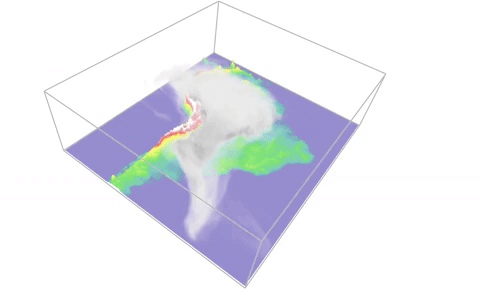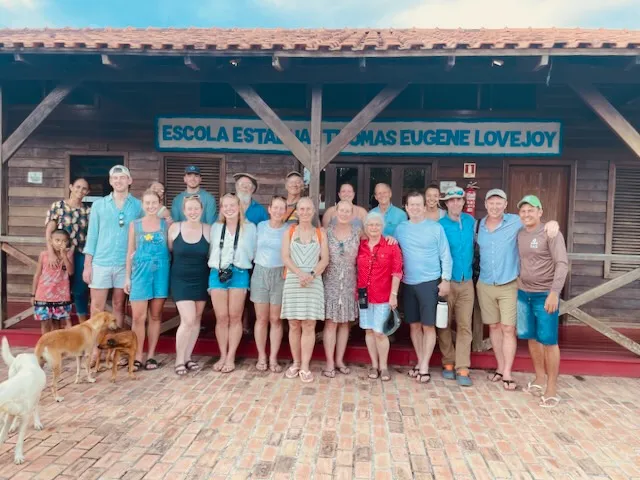[VIDEO] The Amazon Rainforest’s Tipping Point
Filmmaker Matthew Abeler has produced a short film discussing the importance of the hydrological cycle and the Amazon tipping point with Amazon Biodiversity Center founder and President Dr. Thomas Lovejoy and ornithologist Mario Cohn-Haft.
Watch the film here: https://youtu.be/mvvIxGusnSI
Dr. Lovejoy and top Brazilian climate scientist Dr. Carlos Nobre have been warning that the Amazon rainforest is at an irreversible tipping point. The grave concern is that deforestation in the Amazon will lead to disruption of the rainforest’s hydrological cycle and the subsequent collapse of its ecosystem.
Humidity from the Atlantic Ocean creates rains over the eastern Amazon rainforest. The rainforest’s trees take up that precipitation and release a massive amount of moisture into the atmosphere through evaporation off of complex surfaces and transpiration through the leaves. Clouds build up and rain over the rainforest four or five times — each time falling further west over the Amazon before stopping at the Andes Mountains. There the rain drains into the headwaters of the Amazon River, flowing east through the rainforest until it once again reaches the Atlantic Ocean. In this way, the Amazon rainforest creates half of its own rainfall. This is known as the Amazon’s hydrological cycle.

Dr. Lovejoy and Dr. Nobre are raising the alarm that deforestation in the Brazilian Amazon has reached about 20 percent -- the point at which they say that the consequent degradation of the Amazon’s hydrological cycle will result in a tipping point. Climate change and extensive use of fire for clearing are exacerbating the ecosystem problems, and deforestation has been somewhat offset in recent years by recovering vegetation in some abandoned forests.) Beyond this tipping point, tropical rainforest vegetation will convert into grasslands or a drier ecosystem.
The collapse of the Amazon rainforest will lead to an immense loss of biodiversity and to large amounts of carbon dioxide released into the atmosphere, driving greater climate change. Furthermore, because the Amazon moisture contributes to every country in South America (except Chile, since Chile is in the rain shadow of the Andes mountain range), Amazon rainforest collapse will result in the loss of predictable precipitation on which indigenous people of the Amazon rainforest and South American farmers depend.
Learn more about the Amazon tipping point and what can be done at https://www.amazonbiodiversitycenter.org/single-post/2019/12/29/article-amazon-tipping-point-last-chance-for-action.
Learn about the Amazon Biodiversity Center’s efforts to bring conservation research to policy and train new conservation experts at https://www.amazonbiodiversitycenter.org/whats-new.
See Matt Abeler’s other work with Amazon Biodiversity Center here:



![[VIDEO] Exploring what's left of Brazil's Amazon rainforest](https://static.wixstatic.com/media/16e93b_a00b695c67a3449fa185d6adddea96e0~mv2.jpg/v1/fill/w_220,h_123,fp_0.50_0.50,q_90,enc_auto/16e93b_a00b695c67a3449fa185d6adddea96e0~mv2.jpg)








![[ARTICLE] Preserving forests is an essential climate solution...yet we are failing](https://static.wixstatic.com/media/16e93b_2186718cb00d4b999bef3c650ad61015~mv2.jpg/v1/fill/w_38,h_25,fp_0.50_0.50,q_90,enc_auto/16e93b_2186718cb00d4b999bef3c650ad61015~mv2.jpg)

![[VIDEO] Learn More About the Amazon Rainforest's Native Bird Species](https://static.wixstatic.com/media/16e93b_3f2044e90ead4ef193a66fd3efd09f28~mv2.jpg/v1/fill/w_38,h_21,fp_0.50_0.50,q_90,enc_auto/16e93b_3f2044e90ead4ef193a66fd3efd09f28~mv2.jpg)

![[FUNDRAISER] Help Amazon Rainforest Field Assistants Impacted by COVID-19](https://static.wixstatic.com/media/16e93b_a90b4dc9be8149a0b6d947f8b069be8b~mv2.jpg/v1/fill/w_38,h_68,fp_0.50_0.50,q_90,enc_auto/16e93b_a90b4dc9be8149a0b6d947f8b069be8b~mv2.jpg)


![[ARTICLES] Dr. Lovejoy on the future of the Amazon rainforest](https://static.wixstatic.com/media/b5a942_c99239719cb14099bdfab987c9574ee0~mv2.jpg/v1/fill/w_38,h_25,fp_0.50_0.50,q_90,enc_auto/b5a942_c99239719cb14099bdfab987c9574ee0~mv2.jpg)

